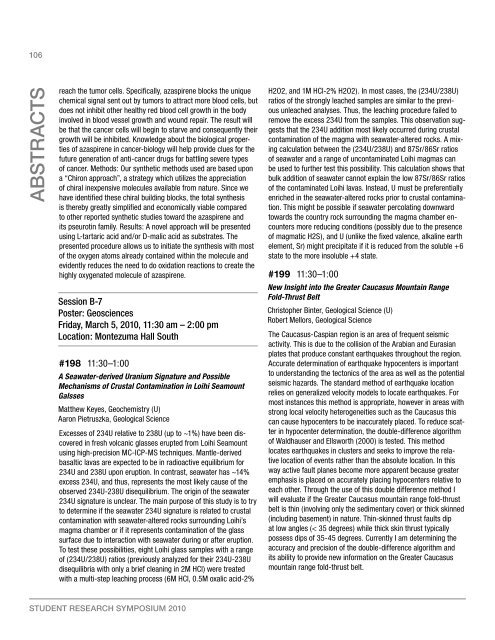STUDENT RESEaRch SympoSiUm 2010 - Graduate and Research ...
STUDENT RESEaRch SympoSiUm 2010 - Graduate and Research ...
STUDENT RESEaRch SympoSiUm 2010 - Graduate and Research ...
You also want an ePaper? Increase the reach of your titles
YUMPU automatically turns print PDFs into web optimized ePapers that Google loves.
106<br />
AbstrActs<br />
reach the tumor cells. Specifically, azaspirene blocks the unique<br />
chemical signal sent out by tumors to attract more blood cells, but<br />
does not inhibit other healthy red blood cell growth in the body<br />
involved in blood vessel growth <strong>and</strong> wound repair. The result will<br />
be that the cancer cells will begin to starve <strong>and</strong> consequently their<br />
growth will be inhibited. Knowledge about the biological properties<br />
of azaspirene in cancer-biology will help provide clues for the<br />
future generation of anti-cancer drugs for battling severe types<br />
of cancer. Methods: Our synthetic methods used are based upon<br />
a “Chiron approach”, a strategy which utilizes the appreciation<br />
of chiral inexpensive molecules available from nature. Since we<br />
have identified these chiral building blocks, the total synthesis<br />
is thereby greatly simplified <strong>and</strong> economically viable compared<br />
to other reported synthetic studies toward the azaspirene <strong>and</strong><br />
its pseurotin family. Results: A novel approach will be presented<br />
using L-tartaric acid <strong>and</strong>/or D-malic acid as substrates. The<br />
presented procedure allows us to initiate the synthesis with most<br />
of the oxygen atoms already contained within the molecule <strong>and</strong><br />
evidently reduces the need to do oxidation reactions to create the<br />
highly oxygenated molecule of azaspirene.<br />
Session B-7<br />
Poster: Geosciences<br />
Friday, March 5, <strong>2010</strong>, 11:30 am – 2:00 pm<br />
Location: Montezuma Hall South<br />
#198 11:30–1:00<br />
A Seawater-derived Uranium Signature <strong>and</strong> Possible<br />
Mechanisms of Crustal Contamination in Loihi Seamount<br />
Galsses<br />
Matthew Keyes, Geochemistry (U)<br />
Aaron Pietruszka, Geological Science<br />
Excesses of 234U relative to 238U (up to ~1%) have been discovered<br />
in fresh volcanic glasses erupted from Loihi Seamount<br />
using high-precision MC-ICP-MS techniques. Mantle-derived<br />
basaltic lavas are expected to be in radioactive equilibrium for<br />
234U <strong>and</strong> 238U upon eruption. In contrast, seawater has ~14%<br />
excess 234U, <strong>and</strong> thus, represents the most likely cause of the<br />
observed 234U-238U disequilibrium. The origin of the seawater<br />
234U signature is unclear. The main purpose of this study is to try<br />
to determine if the seawater 234U signature is related to crustal<br />
contamination with seawater-altered rocks surrounding Loihi’s<br />
magma chamber or if it represents contamination of the glass<br />
surface due to interaction with seawater during or after eruption.<br />
To test these possibilities, eight Loihi glass samples with a range<br />
of (234U/238U) ratios (previously analyzed for their 234U-238U<br />
disequilibria with only a brief cleaning in 2M HCl) were treated<br />
with a multi-step leaching process (6M HCl, 0.5M oxalic acid-2%<br />
<strong>STUDENT</strong> RESEARCH SYMPOSIUM <strong>2010</strong><br />
H2O2, <strong>and</strong> 1M HCl-2% H2O2). In most cases, the (234U/238U)<br />
ratios of the strongly leached samples are similar to the previous<br />
unleached analyses. Thus, the leaching procedure failed to<br />
remove the excess 234U from the samples. This observation suggests<br />
that the 234U addition most likely occurred during crustal<br />
contamination of the magma with seawater-altered rocks. A mixing<br />
calculation between the (234U/238U) <strong>and</strong> 87Sr/86Sr ratios<br />
of seawater <strong>and</strong> a range of uncontaminated Loihi magmas can<br />
be used to further test this possibility. This calculation shows that<br />
bulk addition of seawater cannot explain the low 87Sr/86Sr ratios<br />
of the contaminated Loihi lavas. Instead, U must be preferentially<br />
enriched in the seawater-altered rocks prior to crustal contamination.<br />
This might be possible if seawater percolating downward<br />
towards the country rock surrounding the magma chamber encounters<br />
more reducing conditions (possibly due to the presence<br />
of magmatic H2S), <strong>and</strong> U (unlike the fixed valence, alkaline earth<br />
element, Sr) might precipitate if it is reduced from the soluble +6<br />
state to the more insoluble +4 state.<br />
#199 11:30–1:00<br />
New Insight into the Greater Caucasus Mountain Range<br />
Fold-Thrust Belt<br />
Christopher Binter, Geological Science (U)<br />
Robert Mellors, Geological Science<br />
The Caucasus-Caspian region is an area of frequent seismic<br />
activity. This is due to the collision of the Arabian <strong>and</strong> Eurasian<br />
plates that produce constant earthquakes throughout the region.<br />
Accurate determination of earthquake hypocenters is important<br />
to underst<strong>and</strong>ing the tectonics of the area as well as the potential<br />
seismic hazards. The st<strong>and</strong>ard method of earthquake location<br />
relies on generalized velocity models to locate earthquakes. For<br />
most instances this method is appropriate, however in areas with<br />
strong local velocity heterogeneities such as the Caucasus this<br />
can cause hypocenters to be inaccurately placed. To reduce scatter<br />
in hypocenter determination, the double-difference algorithm<br />
of Waldhauser <strong>and</strong> Ellsworth (2000) is tested. This method<br />
locates earthquakes in clusters <strong>and</strong> seeks to improve the relative<br />
location of events rather than the absolute location. In this<br />
way active fault planes become more apparent because greater<br />
emphasis is placed on accurately placing hypocenters relative to<br />
each other. Through the use of this double difference method I<br />
will evaluate if the Greater Caucasus mountain range fold-thrust<br />
belt is thin (involving only the sedimentary cover) or thick skinned<br />
(including basement) in nature. Thin-skinned thrust faults dip<br />
at low angles (< 35 degrees) while thick skin thrust typically<br />
possess dips of 35-45 degrees. Currently I am determining the<br />
accuracy <strong>and</strong> precision of the double-difference algorithm <strong>and</strong><br />
its ability to provide new information on the Greater Caucasus<br />
mountain range fold-thrust belt.


